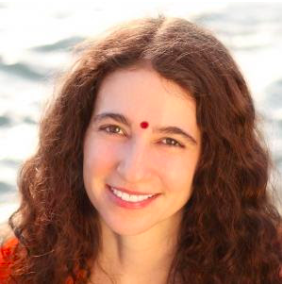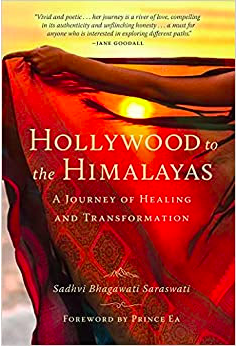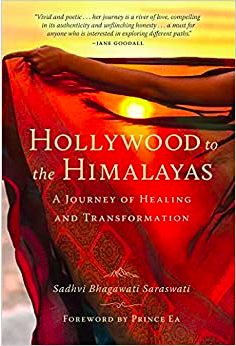Hollywood to the Himalayas
By Sadhvi Bhagawati Saraswati
 People ask, “How did your seva begin?” “How did you start working for Pujya Swamiji?”
People ask, “How did your seva begin?” “How did you start working for Pujya Swamiji?”
The seva began on the fourth or fifth day after I arrived. My eyes were flooded with tears, the beach within my heart being shaped by waves of love rising and crashing on the shore, each wave so high I was sure it would drown my very heartbeat.
I saw Pujya Swamiji three times each day: at morning and afternoon darshan, and in the evening aarti, during which I joined the yellow-clad boys and orange-robed sadhus (Hindu monks) to stand on the steps leading to the river’s edge and sing along to words I didn’t understand.
Each evening as we sang, I felt a hand gently reach into my chest, grab hold of my heart, my lungs, and every physical aspect of “me,” and carry me by my internal organs the way a mother cat carries her kittens by the skin of their necks to a plane of existence I’d never before encountered. It was not a physical plane. There were no distinct mountains or rivers or grassy fields. It was not a visual experience at all. It was an entirely different state of being.
When I opened my eyes, I was still physically there, on the edge of the flowing Ganga River. Yet I was carried to a different level of perspective and experience, one in which there was no yesterday, today, or tomorrow. Time wasn’t linear; simultaneous moments overlapped in a carefully woven tapestry of existence.
Nor was space linear. When I opened my eyes, I could recognize that the legs that moved by force of my brain were standing atop some marble steps that led, one after the other, into the river. So I knew I was “here”—this was where the body stood—and yet I was not here. I was taken to a simultaneous, separate plane of existence, carried deeper and deeper by the songs Pujya Swamiji sang. Each note took me into a realm where I was both the legs that came out of my torso and the legs that came out of everyone’s torso, and also I was everyone’s torsos, arms, heads, and ears, and the steps on which we stood, and I was the water flowing over the marble. With a gentle shift in focus, I was all of these.
After aarti, after the wave of yellow- and orange-clad students and renunciants receded back into the ashram, I continued to sit, my eyes merging and melting into the water, now incandescent in the moonlight. It felt to me like there had never been a moment prior to this one. All of time was now. The twenty-five pre-India years of my life seemed a canvas on which a child had painted and I had once glimpsed and smiled at.
 One afternoon, as Pujya Swamiji stood to leave from the afternoon darshan, he looked down at me, still seated on the ground, waiting for my legs to regain sensation so I could stand. “You can come at 6:30 a.m. tomorrow, after the prayers,” he said. Come? Come where? He had already brought me to what seemed to be the furthest reaches.
One afternoon, as Pujya Swamiji stood to leave from the afternoon darshan, he looked down at me, still seated on the ground, waiting for my legs to regain sensation so I could stand. “You can come at 6:30 a.m. tomorrow, after the prayers,” he said. Come? Come where? He had already brought me to what seemed to be the furthest reaches.
“Where should I come?” I asked in a whisper, as though my vocal cords had gone to sleep with my legs.
“Just come here to this room,” he replied. “One of the boys will bring you in to see me.”
With that he turned and left, vanishing through the magic door into his quarters—his sleeping, eating, and meeting rooms. Beyond that door, it had seemed to me, was the land beyond the Phantom Tollbooth, a Kingdom of Wisdom I’d never be able to visit.
The next morning, I was up before my alarm buzzed at four o’clock. All through the prayers, which include Hindi and Sanskrit chanting and then a Hindi discourse, I was edgy with excitement. What would it be like in the inner sanctum? What would Swamiji say? Or do? Each previous morning, I had effortlessly entered a state of meditation. The words of the songs and the lectures were music to my ears. Not understanding Hindi was a blessing. When we don’t speak a language, the language center seems to shut off, and sound is processed as just sound. And each word brought tears to my eyes.
If I didn’t understand, why was I crying? What was touching me so deeply? We process only the most superficial aspects of communication through our language centers, I believe. The rest of communication takes place elsewhere—perhaps in the body, the nervous system, or the soul. In any case, meditation came easily each morning, as I was undistracted by the meaning of what was being said. The chorus of men and women on separate sides of the hall bursting forth into “Hari Om” as the clock tower struck five soothed my mind to stillness.
This is an excerpt from Hollywood to the Himalayas by Sadhvi Bhagawati Saraswati.
To order your copy, click here.
 Sadhvi Bhagawati Saraswati, a renowned spiritual leader and motivational speaker, is based in Rishikesh, India. Originally from Los Angeles, California, and a graduate of Stanford University, Sadhviji has lived on the banks of the sacred Ganga river, in the lap of the Himalayas for nearly 25 years engaged in spiritual service, wisdom teaching, sacred action, and deep spiritual practice.
Sadhvi Bhagawati Saraswati, a renowned spiritual leader and motivational speaker, is based in Rishikesh, India. Originally from Los Angeles, California, and a graduate of Stanford University, Sadhviji has lived on the banks of the sacred Ganga river, in the lap of the Himalayas for nearly 25 years engaged in spiritual service, wisdom teaching, sacred action, and deep spiritual practice.
At Parmarth Niketan, Rishikesh, where she lives most of the year, she gives daily spiritual discourses (satsang), teaches meditation, provides spiritual counseling and mentoring, and oversees myriad charitable and humanitarian projects and activities.
Her book, Hollywood to the Himalayas: A Journey of Healing and Transformation, is an enlightening memoir of a reluctant spiritual seeker who finds her true self and lifelong calling when she travels to India. Now one of the preeminent female spiritual teachers in the world, Sadhvi recounts her journey with wit, honesty, and clarity, and along the way offers teachings to help us all step onto our own path of awakening and discover the truth of who we really are — expansive love, perfection, and an embodiment of the Divine.
Sadhviji serves as:
- Secretary-General of the Global Interfaith WASH Alliance, an international interfaith organization dedicated to clean water, sanitation, and hygiene (WASH)
- President of Divine Shakti Foundation, a foundation which runs free schools, vocational training programs, and empowerment programs
- Director Of The World-Famous International Yoga Festival At Parmarth, which has been covered In Time magazine, CNN, The New York Times, and other prestigious publications
Sadhviji gives keynote addresses at large forums on a wide variety of topics, ranging from conscious business... to science and spirituality... to sustainable development... to the keys of happiness and peace in life... to all aspects of yoga. Her talks blend the knowledge and logic of the West with the insights, spirituality, and wisdom of the East, serving as a spiritual bridge between the two cultures.
She has spoken at several United Nations events, including with the Secretary-General and Deputy Secretary-General of the UN, and at many high-level international conferences and summits
She has been featured in CNN, The New York Times, Discovery Channel, Travel Channel, BBC, NPR, The Times of India, Dainik Jagran, and many other media outlets.
Sadhviji has received numerous national and international awards and recognition for her work with water, sanitation, and hygiene, and with women’s upliftment and empowerment.
Catalyst is produced by The Shift Network to feature inspiring stories and provide information to help shift consciousness and take practical action. To receive Catalyst twice a month, sign up here.
This article appears in: 2021 Catalyst, Issue 13 - Awakening With Spirit Summit



